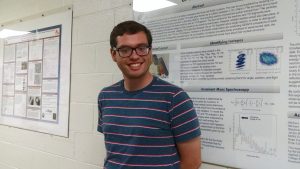
Research Advisor: Dr. Paul DeYoung
One of the primary goals of nuclear physics research is to better understand the force that binds nucleons. This can be accomplished by studying the structure of neutron-rich isotopes. For this experiment, excited 25O nuclei were formed by a collision between a 101.3 MeV/u 27Ne ion beam and a liquid deuterium target at the National Superconducting Cyclotron Laboratory. One resulting reaction involved two-proton removal from 27Ne particles, which created excited 25O nuclei that decayed into three neutrons and an 22O fragment. The four-vectors for the neutrons and 22O fragments were determined, allowing the calculation of the decay energy for this process on an event-by-event basis. However, another reaction would also take place, in which an alpha particle was stripped from the beam, creating 23O nuclei that decayed into an 22O fragment and a single neutron. In order to distinguish between 22O fragments and neutrons from both 25O and 23O isotopes, members of the MoNA collaboration are conducting GEANT4 simulations of each decay process in order to uncover their distinguishing characteristics. By successfully correlating simulated decay processes to experimental data, the relative cross sections of the two decay processes will be determined, and their decay energies will reveal more about their nuclear structures.
This work is supported by the National Science Foundation under grants No. PHY-1306074 and No. DUE-1153600; and by the Hope College Division of Natural and Applied Sciences and the Hope College Department of Physics.